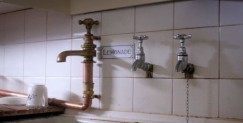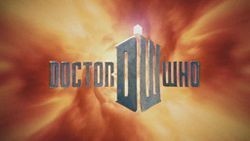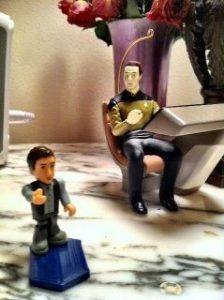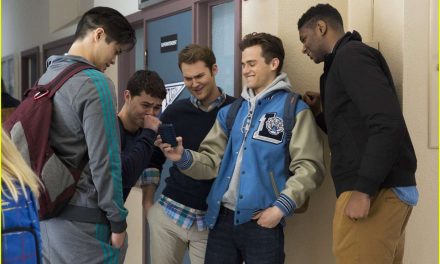
My Doctor Who class at the BBC Television Centre, January 2012
In “The Doctor, the Widow, and the Wardrobe,” the 2011 Doctor Who Christmas special, our eponymous hero remodels a kitchen, installing his own idiosyncratic plumbing: faucets for hot and cold running water, of course and . . .

Screen capture from “The Doctor, the Widow, and the Wardrobe” (Doctor Who Christmas Special, 2012).
To the Arwell children, their eyes full-of-wonder, the Doctor responds (not for the first time in the episode) with a simple, enthusiastic, knowing “I know.”
Not too long ago I didn’t know. When I joined the faculty of Brunel University in London in the Fall of 2006, I barely knew Who. I had seen (and almost completely forgotten) an episode or two of the old Who (which had aired on PBS in America long ago), and as a television scholar I, of course, was well aware of its legendary status and incredibly long run. But now, my television tax all paid up, my Radio Times at the ready, I would be able to watch the series as an actual “Doctor Who is on tonight” viewer in the Doctor’s beloved London.1
It was probably inevitable I would have a “Come to Who” moment wherever I lived. As I was preparing for my expatriate experience, Nicola Dodson’s essay “The Regeneration of Doctor Who: The Ninth Doctor and the Influence of the Slayer” appeared in FLOW (April 28th, 2006). How could I, the so-called “father of Buffy Studies,” not pay attention? Soon after the crossing, I was also asked to be an internal examiner for a Ph.D. dissertation on Doctor Who, an excellent piece of research which taught me much and made want to know more.
I bought the first two series of Russell T. Davies’s Who on Region 2 DVDs and watched them avidly over a few days, loving Tennant’s 10th Doctor much, much more than Eccleston’s 9th, and then enjoying the 2006 Christmas special, “Runaway Bride, the first Donna Noble (Catherine Tate) episode, after I returned from holidaying in the States. Later, when the 3rd and 4th “series” of New Who aired on the BBC in the springs of 2007 and 2008, I would follow both runs from week to week in my flat in Turnpike Lane. The dawn of the Steven Moffat era in the Spring of 2010 would find me back in the USA, following the adventures of the 11th Doctor (my third) on BBC America (soon to be headed by BBC Wales’ Julie Gardner, who had commissioned Who’s return in 2005) and on iTunes. I was hooked. In my imagination I now wear bow ties and fezes (both cool).

This past December I even taught a course on Doctor Who in London in an American study abroad program. For two weeks we ate, drank, and slept Who over breakfast at the Washington Mayfair Hotel, in pubs, on the tube and trains, while looking down at the city from the London Eye, at Stonehenge, in Cardiff, at the BBC Television Centre, at Forbidden Planet, and when Steven Peacock came to share with us his two takes (1, 2) on Moffat’s Who.2
And of course we went to the fabulous, recently-closed/reappearing-soon-in-Cardiff Doctor Who Experience. With my fellow “shoppers,” as the 11th Doctor (Matt Smith), narrating the whole shebang, deemed us, snidely, during our excursion, we took a trip on the TARDIS, encountered Daleks and Cybermen and Weeping Angels, and roamed the gift shop, where I secured a tiny Rory for a friend at home with a serious crush on Amy Pond’s guy. Who am I to question her repurposing her gift with a sentient android from another TV ‘verse?

Rory meets Star Trek: The Next Generation’s Data. Photo by Kelly Hays.
For two weeks, the words “I know”—whether concerned with Strongbow cider, a cappuccino at Costa’s, a departure time, Tesco’s, a meal at Wagamamas, or bangers and mash—became our mantra and our favorite inside, cult joke.
Just before we left London a snarky piece by Nick Curtis appeared in The Evening Standard pitting two legendary British icons: Sherlock Holmes, then returning to the small screen in the second series of Moffat and Mark Gattis’ Sherlock, and, of course, The Doctor. Curtis, to the class’s consternation, found The Doctor wanting. Here’s the last paragraph:
Large chunks of both Doctor Who and Sherlock are shot in and around Cardiff, and much play has been made of how this has turned the city into a sort of miniature, damp Hollywood (Llangollywd, perhaps). In Doctor Who, the entire universe looks like Wales. Sherlock, meanwhile, has the whole of modern London to play with. Just think of the use of the Thames and the skyline in A Scandal in Belgravia, the witty exteriors including a down-at-heel Baker Street and the beautiful Georgian interiors of Irene’s bondage parlour. Ultimately, perhaps, it’s this that makes Sherlock better than Who right now. The Doctor belongs to the universe. Holmes belongs to us. He’s a Londoner.
We, of course, were not Londoners and we were on the Doctor’s side (we trusted him—he’s the Doctor). For all of Sherlock’s brilliance, we would rather be in the TARDIS than walking Baker Street.
In “The Doctor’s Wife,” the sterling, Neil Gaiman-authored Series 6 episode the Doctor’s spaceship/time machine, now embodied in a woman named Idris, disabuses him of several mistaken notions in the sort of de/remythologizing new Who has became famous for.
DOCTOR: Who are you?
IDRIS: Do you not know me? Just because they put me in here?
DOCTOR: They said you were dangerous.
IDRIS: Not the cage, stupid. In here. They put me in here. I’m the . . . Oh, what do you call me? We travel. I go . . . (she makes the sound of the TARDIS)
DOCTOR: The TARDIS?
IDRIS: Time and relative dimension in space. Yes, that’s it. Names are funny. It’s me! I’m the TARDIS.
DOCTOR: No. You’re not! You’re a bitey, mad lady. The TARDIS is up and downy stuff in a big blue box.
IDRIS: Yes, that’s me. A type 40 TARDIS. I was already a museum piece, when you were young, and the first time you touched my console you said . . .
DOCTOR: I said you were the most beautiful thing I had ever known.
IDRIS: And then you stole me. And I stole you.
DOCTOR: I borrowed you.
IDRIS: Borrowing implies the eventual intention to return the thing that was taken. What makes you think I would ever give you back?
DOCTOR: You’re the TARDIS?
IDRIS: Yes.
DOCTOR: My TARDIS?
Our TARDIS! Later, however, Idris has a very big question for the Doctor:
IDRIS: Are all people like this?
DOCTOR: Like what?
IDRIS: So much bigger on the inside? I’m… Oh, what is that word? It’s so big, so complicated.
Coming to Who has made me bigger, more complicated—on the inside, and more than a little British.

The TARDIS goes forward in time as well, and now I can see . . . the University of Hertfordshire will be hosting a conference honoring Who’s fiftieth anniversary, 3-5 September 2013. I will have the honor of giving a talk.
“I know!”
David Lavery is the author of over one hundred and twenty published essays and reviews and author/co-author/editor/co-editor of twenty books published or under contract. He is also the organizer of international conferences on Buffy the Vampire Slayer, The Sopranos, and Lost, a co-founding editor of the journals Slayage: The Online International Journal of Buffy Studies and Critical Studies in Television, he has lectured around the world on the subject of television (Australia, Turkey, the UK, Portugal, New Zealand, Ireland, Germany) and has been a guest/source for the BBC, NPR, the Australian Broadcasting Corporation, The New York Times, A Folha de Sao Paulo (Brazil), Publica(Portugal), The Toronto Star, USA Today. To learn more about him, visit his home page. His C.V (in PDF) is also available.
1 In a recent episode of Big Bang Theory Amy Farrah Fowler observes that “For somebody who has a machine that allows him to travel anywhere in space and time, Doctor Who certainly has an affection for modern day London” (“The Beta Test Initiation,” 5.14). ↩
2 For a sample of the excellent work my American Whoers produced, go here. ↩





